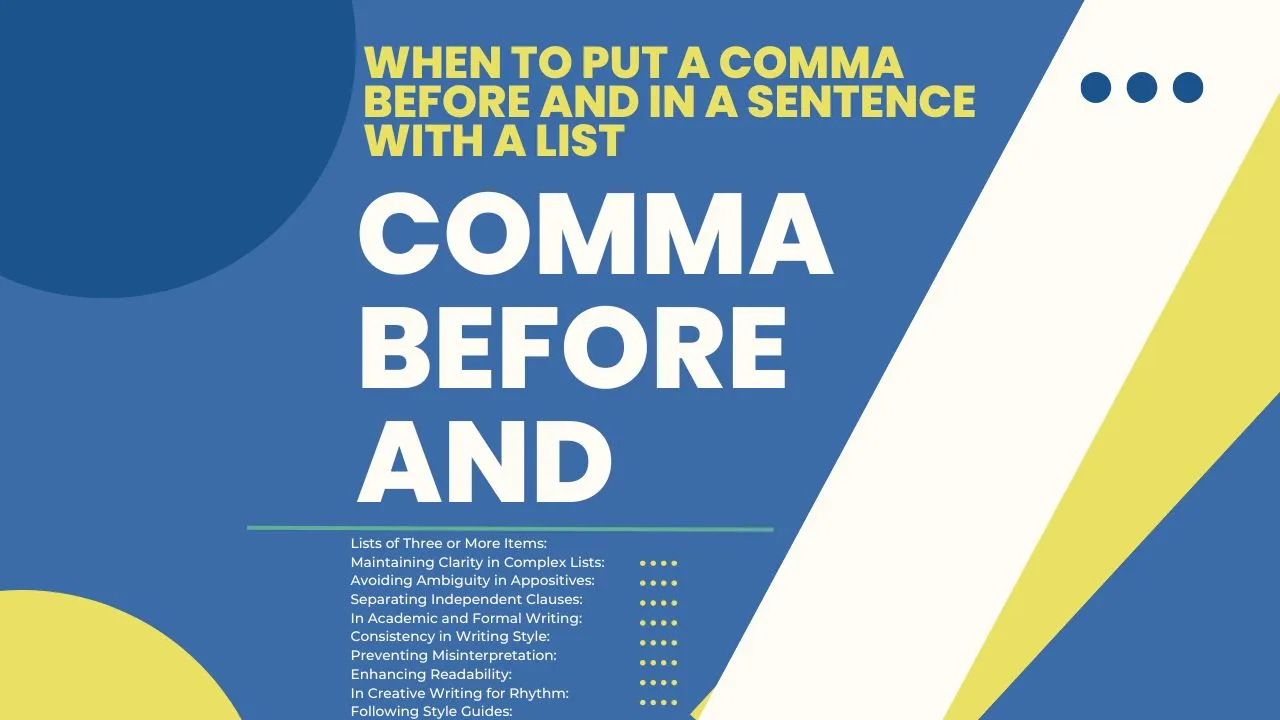In the vast landscape of punctuation, commas play a crucial role in enhancing the clarity and structure of written content. One specific area where writers often find themselves contemplating the correct usage is when dealing with lists and the conjunction “and.” Let’s delve into the nuances of when to put a comma before “and” in a sentence with a list.
Understanding Commas in Lists:
Before we explore the intricacies of when to put a comma before “and” in a Sentence, it’s essential to grasp the general use of commas in lists. Commas serve as separators between items, ensuring that the reader can easily distinguish between individual elements.
When to Use Commas Before “And”:
Now, let’s pinpoint the instances of when to put a comma before and in a Sentence incorporating a comma before “and” becomes imperative. Typically, this practice is recommended when listing three or more items. For example:
1. Lists of Three or More Items:
The most common instance is when you’re listing three or more items.
For example: I need to buy eggs, milk, and bread.
2. Maintaining Clarity in Complex Lists:
In complex lists where items themselves contain commas, adding a comma before the final “and” helps maintain clarity.
For example: The exhibition featured artists from New York, the USA, Tokyo, Japan, and Sydney, Australia.
3. Avoiding Ambiguity in Appositives:
When “and” is part of an appositive phrase, a comma before it avoids confusion.
For example: “My favorite authors, J.K. Rowling, and George R.R. Martin, inspire me.”
4. Separating Independent Clauses:
In compound sentences with two independent clauses connected by “and,” use a comma before the conjunction.
For example: She enjoys hiking, and he prefers biking.
5. In Academic and Formal Writing:
Academic and formal writing styles often adhere to strict punctuation rules. Including a comma before “and” in lists is considered standard practice.
6. Consistency in Writing Style:
Maintaining consistency is crucial. If you start using a comma before “and” in a list, ensure that this practice remains consistent throughout your document.
7. Preventing Misinterpretation:
Commas before “and” help prevent misinterpretation, especially when the absence of a comma might lead to ambiguity.
Example: I want to thank my parents, Ayn Rand and God. (Incorrect)
Example: I want to thank my parents, Ayn Rand, and God. (Correct)
8. Enhancing Readability:
Commas contribute to the overall readability of your content. They act as visual cues, guiding readers through your sentences effortlessly.
9. In Creative Writing for Rhythm:
In creative writing, commas before “and” can be used to enhance rhythm and pacing. Experiment with punctuation to achieve the desired flow.
10. Following Style Guides:
Many style guides, such as APA and Chicago, recommend using a comma before “and” in lists. Adhering to these guidelines ensures alignment with established writing norms.
Understanding these instances empowers writers to navigate the comma conundrum effectively. While the rules may seem nuanced, mastering the art of using commas before “and” elevates your writing, making it more precise and engaging for your audience.
Maintaining Consistency in Writing:
Consistency is key in effective writing. Once you decide to include a comma before “and” in a list, ensure that this practice is maintained throughout your content. Consistency not only promotes readability but also establishes a sense of coherence.
Significance of Comma Placement
The placement of commas can affect the meaning of a sentence. Understanding the conventions and rules surrounding comma usage is crucial for effective writing.
Comma Rules and Conventions
General Guidelines for Comma Usage
Commas are typically used to separate items in a list, set off introductory phrases, and delineate clauses. Understanding these general guidelines is fundamental to mastering comma usage.
The Role of Commas in Sentence Structure
Commas contribute to the overall structure of a sentence. Proper placement enhances readability and helps convey the intended meaning with precision.
Impact of Comma Placement on Clarity
Clarity in communication is the ultimate goal. We’ll explore how thoughtful comma placement contributes to unambiguous writing.
“And” in Sentences
Conjunctions and Their Function
Conjunctions, such as “and,” connect words, phrases, or clauses. The placement of a comma before “and” can influence the relationship between these elements.
Common Practices for Comma Placement with “And”
While there are conventions for using a comma before “and,” different contexts and writing styles may impact this practice. We’ll delve into common scenarios and considerations.
Clarifying Ambiguities in Sentence Structure
Ambiguities can arise when deciding whether to use a comma before “and.” We’ll examine examples and strategies for resolving potential confusion.
The Debate: To Comma or Not to Comma
Different Perspectives on Comma Placement
The question of whether to put a comma before “and” has sparked debates among writers. We’ll explore different perspectives and their reasoning.
Style Guides’ Recommendations
Major style guides, such as APA, MLA, and Chicago, offer insights into comma usage. Navigating these recommendations is essential for adhering to specific writing conventions.
Considering Contextual Factors
Context matters when deciding on comma placement. We’ll discuss how factors such as formality, genre, and audience can influence punctuation choices.
Examples and Analyses
Correct Usage Scenarios
Examining instances of when to put a comma before and in a Sentence will illustrate how this punctuation choice enhances the overall coherence of sentences.
Incorrect Usage Scenarios
Analyzing instances where commas are incorrectly placed before “and” will help writers recognize and avoid common mistakes.
Ambiguities and How to Resolve Them
Ambiguities can arise in complex sentences. We’ll provide guidance on resolving ambiguities to ensure the reader interprets the intended meaning accurately.
Avoiding Ambiguity with Commas:
The absence of a comma before “and” can sometimes lead to ambiguity. Consider the following example:
- I want to thank my parents, Subir Jha and God.
In this case, it appears as if the writer’s parents are Subir Jha and God. Adding a comma resolves this ambiguity:
- I want to thank my parents, Subir Jha, and God.
Common Mistakes to Avoid:
Writers often make errors in comma usage, especially in lists. One common mistake is omitting the serial comma, leading to confusion. Always remember to include that final comma in your lists to maintain clarity.
Grammar Rules and Style Guides:
To navigate the intricacies of comma usage, it’s beneficial to consult grammar rules and style guides. Different style guides may provide specific recommendations, so it’s advisable to adhere to the guidelines relevant to your writing context.
Different Approaches in Various Writing Styles:
Comma usage can vary across different writing styles. While formal writing may demand strict adherence to grammar rules, informal or journalistic styles might allow for more flexibility. Familiarize yourself with the conventions of your chosen style.
Reader Engagement and Comma Placement:
Believe it or not, proper comma usage contributes to reader engagement. Punctuation serves as a guide, leading readers through your sentences with ease. A well-placed comma can make the difference between a smooth reading experience and a disjointed one.
Maintaining Flow in Writing:
Commas, when used judiciously, contribute to the natural flow of sentences. When listing items, the inclusion of commas ensures a rhythm that readers find comfortable to follow. Consider the flow in the following example:
- She excelled in singing, dancing, painting, and acting.
Practical Examples in Everyday Writing:
To solidify your understanding, let’s explore practical examples from everyday writing. Consider a shopping list without commas:
- Apples bananas and oranges.
Now, with proper comma usage:
- Apples, bananas, and oranges.
The latter is not only visually appealing but also aids in comprehension.
Addressing Exceptions and Special Cases:
While the general rule is to use when to put a comma before and in a Sentence in lists, exceptions exist. For instance, in newspaper headlines or certain creative writing contexts, omitting the serial comma may be acceptable. Be aware of these exceptions and apply them judiciously.
Benefits of Proper Punctuation:
The advantages of employing commas effectively in writing are multifaceted. From improved clarity to enhanced readability, proper punctuation contributes significantly to the overall quality of your content.
FAQs on Comma Usage Before “And”:
Do I always need to use a comma before “and” in a list?
While it’s generally recommended, there are exceptions. Consult your style guide for specific requirements.
What is the serial comma, and why is it important?
The serial comma, placed before the conjunction in a list, helps prevent ambiguity and confusion.
Can I omit the serial comma in all cases?
In some styles, like journalistic writing, the serial comma may be optional. However, consistency is key.
Does comma placement vary in different English dialects?
Yes, some differences exist between American and British English. Familiarize yourself with the conventions of your intended audience.
How does proper comma usage impact reader perception?
Proper comma usage enhances reader comprehension and contributes to a positive reading experience.
Conclusion:
In the intricate dance of punctuation, the humble comma holds a significant role. Knowing when to put a comma before “and” in a sentence with a list elevates your writing, ensuring clarity and coherence. As you navigate the world of commas, remember that these small details wield substantial power in crafting exceptional content.







